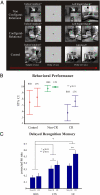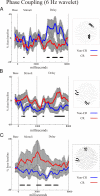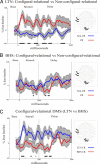Hippocampus-dependent and -independent theta-networks of active maintenance - PubMed (original) (raw)
Hippocampus-dependent and -independent theta-networks of active maintenance
Nathan Cashdollar et al. Proc Natl Acad Sci U S A. 2009.
Abstract
Recent studies in humans and animals raise the possibility that actively maintaining a detailed memory of a scene within working memory may require the hippocampus, a brain structure better known for its role in long-term memory. We show that the hippocampus is behaviorally and functionally critical for configural-relational (CR) maintenance by orchestrating the synchrony of occipital and temporal brain regions in the theta-frequency range. Using magnetoencephalography in healthy adults and patients with bilateral hippocampal sclerosis, we distinguish this hippocampus-dependent theta-network from one that is independent of the hippocampus and used for non-CR scene maintenance. This non-CR theta-network involved frontal and parietal brain regions. We also show that the functional and topographical dissociation between these two networks cannot be accounted for by perceptual difficulty or the amount of information to be maintained ("load"). Also, we confirm in healthy adults that active maintenance of the CR arrangement of objects within a scene is impaired by task-interference during the delay in a manner akin to working-memory maintenance processes. Together, these findings demand reconsideration of the classical functional-anatomical distinctions between long- and short-term memory.
Conflict of interest statement
The authors declare no conflict of interest.
Figures
Fig. 1.
Experimental design and behavioral results for experiments 1 and 3. (A) A non-CR DMS trial where participants are instructed to make a deep encoding “indoor/outdoor” judgment at sample and maintain this information over the delay period to make a “left/right” match decision at test (Top). A CR DMS trial where the configural relationship of items within a scene must be maintained over the delay to make a correct decision at test (Middle). A control trial where participants are not required to maintain any stimulus information to make a discrimination judgment at test (Bottom). (B) Mean behavioral performance in DMS trials in experiment 3 for BHS patients and left temporal lobe epilepsy patients determined to be MRI-negative for hippocampal pathology (LTN). The data show a selective impairment for the BHS group for CR DMS performance (>95% confidence interval; error bars indicate SEM). (C) Mean corrected hit rates of delayed recognition memory for non-CR and CR stimuli in experiment 3 for BHS, LTN, and NC. P values denoting differences between conditions are indicated by asterisks (paired t test, one-tailed, SD).
Fig. 2.
Phase-coupling analysis (6-Hz wavelet) contrasting experimental conditions during delay periods in sensor space for experiment 1 comparing CR and non-CR DMS (Upper), and experiment 2 comparing non-CR DMS load conditions (Lower). In experiment 1, non-CR delay maintenance (A) display increased right frontal and parietal theta-band sensor coupling (blue) compared with the CR DMS delays (B) that increased left occipito-temporal theta-coupling (red). In experiment 2, one-item delay maintenance (C) displayed a similar right frontal and parietal theta-phase coupling (blue) as the non-CR task in experiment 1. The five-item delay (D) increased theta-phase coupling of bifrontal sensor groups (red), a pattern that is nonoverlapping with the CR maintenance sensor coupling of experiment 1.
Fig. 3.
Serial measures t test comparisons of 6-Hz phase coupling on selected sensor groups (shown on right-side insets) for non-CR (in blue) vs. CR (in red) DMS conditions in experiment 1 (significance at P < 0.05 indicated by markings on x axis, see Methods). Non-CR DMS significantly increased theta synchrony of right fronto-parietal sensor groups during delay periods (A). Alternatively, CR DMS engaged a network of left occipito-temporal (B) and fronto-temporal theta synchrony (C) during stimulus encoding and delay periods.
Fig. 4.
Serial measures t test comparisons of 6-Hz phase coupling on selected sensor groups (shown on right-side insets) for non-CR (in blue) vs. CR (in red) DMS conditions in experiment 3. Increased occipito-temporal theta synchrony for CR DMS during encoding and maintenance was significantly enhanced in temporal lobe epilepsy patients without hippocampal lesions (LTN) (A). This theta synchrony increase was absent for identical sensor groups in BHS patients during CR DMS (B). In the encoding and maintenance phase of CR DMS, the LTN (blue) group showed stronger occipito-temporal theta synchrony than the BHS group (red) (C).
Comment in
- Hippocampus and configural-relational information: a relationship confined to memory?
Lee AC, Baxter MG. Lee AC, et al. Proc Natl Acad Sci U S A. 2010 Feb 9;107(6):E21; author reply E22. doi: 10.1073/pnas.0914051107. Epub 2010 Feb 9. Proc Natl Acad Sci U S A. 2010. PMID: 20145115 Free PMC article. No abstract available.
Similar articles
- Hippocampus and configural-relational information: a relationship confined to memory?
Lee AC, Baxter MG. Lee AC, et al. Proc Natl Acad Sci U S A. 2010 Feb 9;107(6):E21; author reply E22. doi: 10.1073/pnas.0914051107. Epub 2010 Feb 9. Proc Natl Acad Sci U S A. 2010. PMID: 20145115 Free PMC article. No abstract available. - Hippocampal theta-phase modulation of replay correlates with configural-relational short-term memory performance.
Poch C, Fuentemilla L, Barnes GR, Düzel E. Poch C, et al. J Neurosci. 2011 May 11;31(19):7038-42. doi: 10.1523/JNEUROSCI.6305-10.2011. J Neurosci. 2011. PMID: 21562265 Free PMC article. - Transcranial alternating current stimulation at theta frequency to left parietal cortex impairs associative, but not perceptual, memory encoding.
Meng A, Kaiser M, de Graaf TA, Dücker F, Sack AT, De Weerd P, van de Ven V. Meng A, et al. Neurobiol Learn Mem. 2021 Jul;182:107444. doi: 10.1016/j.nlm.2021.107444. Epub 2021 Apr 23. Neurobiol Learn Mem. 2021. PMID: 33895350 - Hippocampal theta rhythm: a tag for short-term memory.
Vertes RP. Vertes RP. Hippocampus. 2005;15(7):923-35. doi: 10.1002/hipo.20118. Hippocampus. 2005. PMID: 16149083 Review. - Hippocampus, theta, and spatial memory.
O'Keefe J. O'Keefe J. Curr Opin Neurobiol. 1993 Dec;3(6):917-24. doi: 10.1016/0959-4388(93)90163-s. Curr Opin Neurobiol. 1993. PMID: 8124075 Review.
Cited by
- Trisecting representational states in short-term memory.
Nee DE, Jonides J. Nee DE, et al. Front Hum Neurosci. 2013 Nov 26;7:796. doi: 10.3389/fnhum.2013.00796. Front Hum Neurosci. 2013. PMID: 24324424 Free PMC article. Review. - Auditory-limbic-cerebellum interactions and cognitive impairments in noise-induced hearing loss.
Xu XM, Feng Y, Wang J, Salvi R, Yin X, Gao J, Chen YC. Xu XM, et al. CNS Neurosci Ther. 2023 Mar;29(3):932-940. doi: 10.1111/cns.14028. Epub 2022 Nov 15. CNS Neurosci Ther. 2023. PMID: 36377461 Free PMC article. - Memory integration in amnesia: prior knowledge supports verbal short-term memory.
Race E, Palombo DJ, Cadden M, Burke K, Verfaellie M. Race E, et al. Neuropsychologia. 2015 Apr;70:272-80. doi: 10.1016/j.neuropsychologia.2015.02.004. Epub 2015 Mar 6. Neuropsychologia. 2015. PMID: 25752585 Free PMC article. - Cholinergic modulation of the CAN current may adjust neural dynamics for active memory maintenance, spatial navigation and time-compressed replay.
Yoshida M, Knauer B, Jochems A. Yoshida M, et al. Front Neural Circuits. 2012 Mar 15;6:10. doi: 10.3389/fncir.2012.00010. eCollection 2012. Front Neural Circuits. 2012. PMID: 22435051 Free PMC article. - Frontoparietal Network Connectivity During an _N_-Back Task in Adults With Autism Spectrum Disorder.
Yuk V, Urbain C, Anagnostou E, Taylor MJ. Yuk V, et al. Front Psychiatry. 2020 Sep 9;11:551808. doi: 10.3389/fpsyt.2020.551808. eCollection 2020. Front Psychiatry. 2020. PMID: 33033481 Free PMC article.
References
- Buzsaki G, Draguhn A. Neuronal oscillations in cortical networks. Science. 2004;304:1926–1929. - PubMed
Publication types
MeSH terms
LinkOut - more resources
Full Text Sources
Medical



